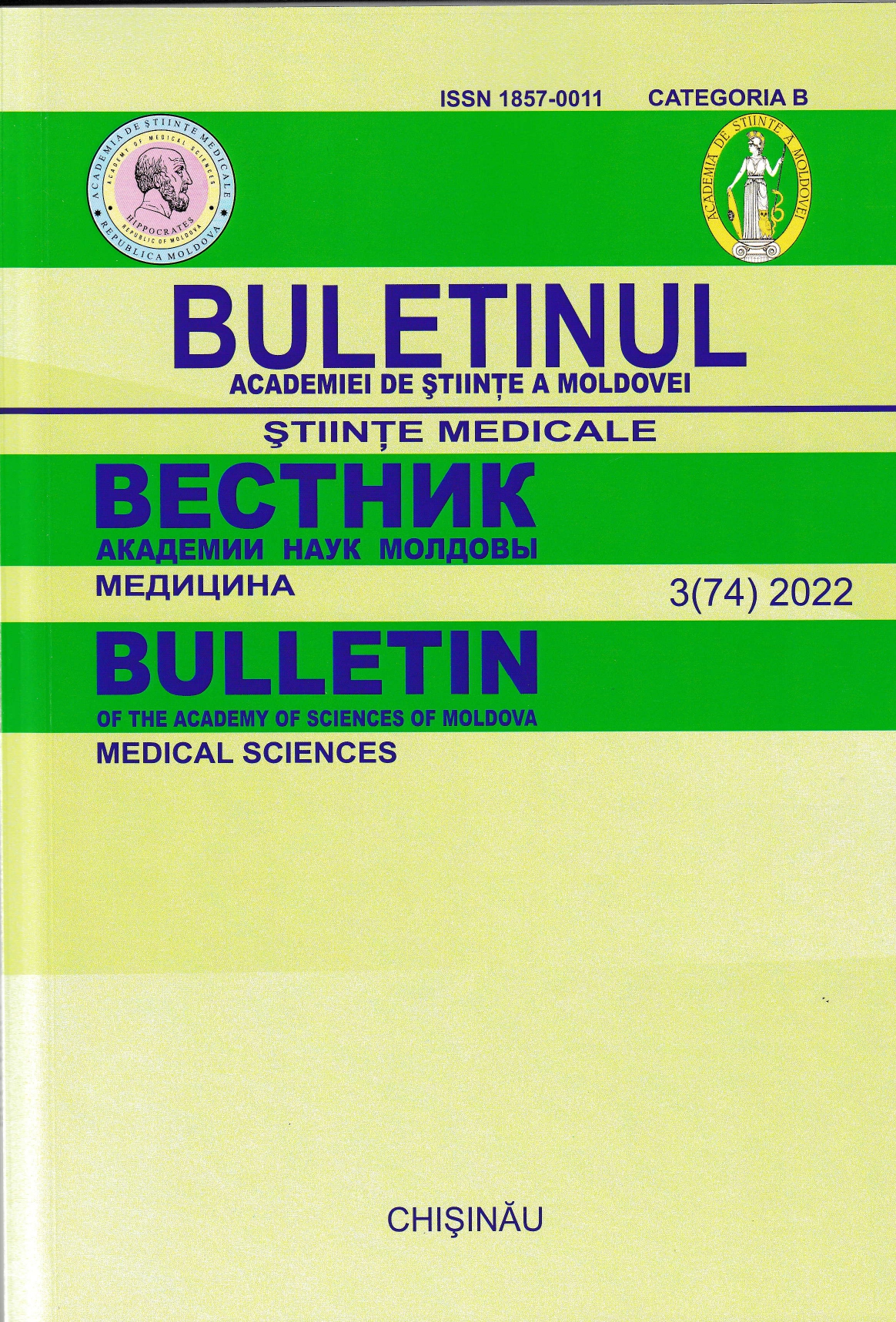Тромбоэмболия легких у больных с инсултом: результаты клинико-анатомического анализа
DOI:
https://doi.org/10.52692/1857-0011.2022.3-74.13Ключевые слова:
инсульт, тромбоэмболия легочной артерии, факторы риск, осложнение, смерть, морфо патологический анализАннотация
Легочная эмболия является основной причиной смертности у пациентов с инсультом и до 50% преждевреенных смертей у госпитализированных пациентов. Неспецифическая клиническая картина является причиной диагностических ошибок и резко ограничивает своевременное начало лечения.Целью исследования был анализ пропущенных случаев тромбоэмболии легочной артерии у пациентов с инсультом, пролеченных в стационарe, путем анализа результатов морфо патологических исследований. Материалы и методы: Ретроспективное исследование. Изучена тромбоэмболия легочной артерии как основная причина смерти больных с инсультом, госпитализированных в НИИ неврологии и нейрохирургии им. Диомида Германа в течение 2017–2020 гг. В исследование включено 13 больных с морфо патологически подтвержденным диагнозом. Результаты. В исследование вошли 5 мужчин (38,5%) и 8 женщин (61,5%), средний возраст 65±5,2 года. У всех больных диагноз инсульта был подтвержден по данным КТ: ишемический инсульт установлен у 6 больных (46,8%), геморрагический инсульт у 4 больных (30,1%), из них оперирован 1 больной (7,7%), инсульт с геморрагической трансформацией у 3 больных (23,1%). У 11 больных (84,6%) инсульт был первичным, а у 2 больных (15,4%) - повторным. Факторами риска были артериальная гипертензия - у 12 больных (92,3%), у 8 больных (61,5%), ожирение, сахарный диабет - у 5 больных (38,5%), мерцательная аритмия у 5 больных (38,5%), у 1 больного (7,7 %) с тромбозом в других областях. Морфо патологический диагноз установил, что причиной смерти во всех случаях явилась тромбоэмболия легочной артерии, но только у 2 (15,4%) больных имелись специфические симптомы. Вывод: Пациенты, перенесшие инсульт, подвержены повышенному риску легочной эмболии из-за постельного режима, паралича конечностей и предрасполагающих факторов риска, но своевременно диагностируется лишь небольшое количество пациентов, поэтому клиницисту важно знать о тяжести течения проблемы и установление строгих протоколов профилактики и лечения.
Библиографические ссылки
Quellette DR, Kamangar N, Harrington A. Pulmonary Embolism. Medscape. Available at http://emedicine.medscape.com/article/300901-overview (last accessed December 2015)
Liu LP, Zheng HG, Wang DZ, et al. Risk assessment of deep-vein thrombosis after acute stroke: a prospective study using clinical factors. CNS Neurosci Ther 2014; 20: 403-10; http://dx.doi.org/10.1111/cns.12227
Pongmoragot J, Rabinstein AA, Nilanont Y, et al.; Investigators of Registry of Canadian Stroke Network (RCSN) and University of Toronto Stroke Program for Stroke Outcomes Research Canada (SORCan [www.sorcan.ca]) Working Group. Pulmonary embolism in ischemic stroke: clinical presentation, risk factors, and outcome. J Am Heart Assoc 2013; 2: e000372
Stein PD, Beemath A, Matta F, et al. Clinical characteristics of patients with acute pulmonary embolism: data from PIOPED II. Am J Med 2007; 120: 871-9; http://dx.doi.org/10.1016/j.amjmed.2007.03.024
Pelliccia F, Schiariti M, Terzano C, et al. Treatment of acute pulmonary embolism: update on newer pharmacologic and interventional strategies. Biomed Res Int 2014; 2014: 410341; http://dx.doi.org/10.1155/2014/410341
Torbicki A, Perrier A, Konstantinides S, et al.; ESC Committee for Practice Guidelines (CPG). Guidelines on the diagnosis and management of acute pulmonary embolism: the Task Force for the Diagnosis and Management of Acute Pulmonary Embolism of the European Society of Cardiology (ESC). Eur Heart J 2008; 29: 2276-315; http://dx.doi.org/10.1093/eurheartj/ehn310
Piazza G, Goldhaber SZ. Acute pulmonary embolism: part II: treatment and prophylaxis. Circulation 2006; 114: e42-7; http://dx.doi.org/10.1161/CIRCULATIONAHA.106.620880
Gensini GF, Zaninelli A, Ricci S, et al. SPREAD, Stroke Prevention And Educational Awareness Diffusion, VII Edizione, Ictus cerebrale: linee guida italiane di prevenzione e trattamento. Raccomandazioni e sintesi. 14 marzo 2012. Available at http://www.siapav.it/pdf/SPREAD%202012.pdf (last accessed December 2015)
Regione Toscana. Linee guida per la profilassi del tromboembolismo venoso nei pazienti ospedalizzati. SNLG Regioni, 2015. Available at http://www.snlg-iss.it/cms/files/LG_Toscana_TEV.pdf (last accessed December 2015)
Barbar S, Noventa F, Rossetto V, et al. A risk assessment model for the identification of hospitalized medical patients at risk for venous thromboembolism: the Padua Prediction Score. J Thromb Haemost 2010; 8: 2450-7; http://dx.doi.org/10.1111/j.1538-7836.2010.04044.x
Kahn SR, Lim W, Dunn AS, et al.; American College of Chest Physicians. Prevention of VTE in nonsurgical patients: Antithrombotic Therapy and Prevention of Thrombosis, 9th ed: American College of Chest Physicians Evidence-Based Clinical Practice Guidelines. Chest 2012; 141 (2 Suppl): e195S-226S
National Institute for Health and Care Excellence. Stroke and transient ischaemic attack in over 16s: diagnosis and initial management. Available at https://www.nice.org.uk/guidance/cg68 (last accessed December 2015)
CLOTS (Clots in Legs Or sTockings after Stroke) Trials Collaboration, Dennis M, Sandercock P, et al. Effectiveness of intermittent pneumatic compression in reduction of risk of deep vein thrombosis in patients who have had a stroke (CLOTS 3): a multicentre randomised controlled trial. Lancet 2013; 382: 516-24; http://dx.doi.org/10.1016/S0140-6736(13)61050-8
Wells PS, Forgie MA, Rodger MA. Treatment of venous thromboembolism. JAMA 2014; 311: 717-28; http://dx.doi.org/10.1001/jama.2014.65; http://dx.doi.org/10.1001/jama.2014.6123
Jauch EC, Saver JL, Adams HP, Bruno A, Connors JJ, Demaerschalk BM, Khatri P, McMullan PW, Qureshi AI, Rosenfield K, Scott PA, Summers DR, Wang DZ, Wintermark M, Yonas H; American Heart Association Stroke Council; Council on Cardiovascular Nursing; Consiliul pentru boala vasculară periferică; Consiliul pentru Cardiologie Clinică . Ghid pentru gestionarea timpurie a pacienților cu AVC ischemic acut: un ghid pentru profesioniștii din domeniul sănătății de la American Heart Association/American Stroke Association. Accident vascular cerebral. 2013; 44:870–947
Lindsay MP, Gubitz G, Bayfey M, Philips S. Canadian Best Practice Recommendations for Stroke Care. Disponibil la: http://www.strokebestpractices.ca. Accesat 27 mai 2013
Lansberg MG, O’Donnell MJ, Khatri P, Lang ES, Nguyen‐Huynh MN, Schwartz NE, Sonnenberg FA, Schulman S, Vandvik PO, Spencer FA, Alonso‐Coello P, Guyatt GH, Akl EA; American College of Chest Physicians. Antithrombotic and thrombolytic therapy for ischemic stroke: antithrombotic therapy and prevention of thrombosis, 9th ed: American College of Chest Physicians Evidence‐Based Clinical Practice Guidelines. Chest. 2012; 141(2 suppl):e601S–e636S. doi:10.1378/chest.11‐2302
Загрузки
Опубликован
Лицензия
Copyright (c) 2022 Вестник Академии Наук Молдовы. Медицина

Это произведение доступно по лицензии Creative Commons «Attribution» («Атрибуция») 4.0 Всемирная.



